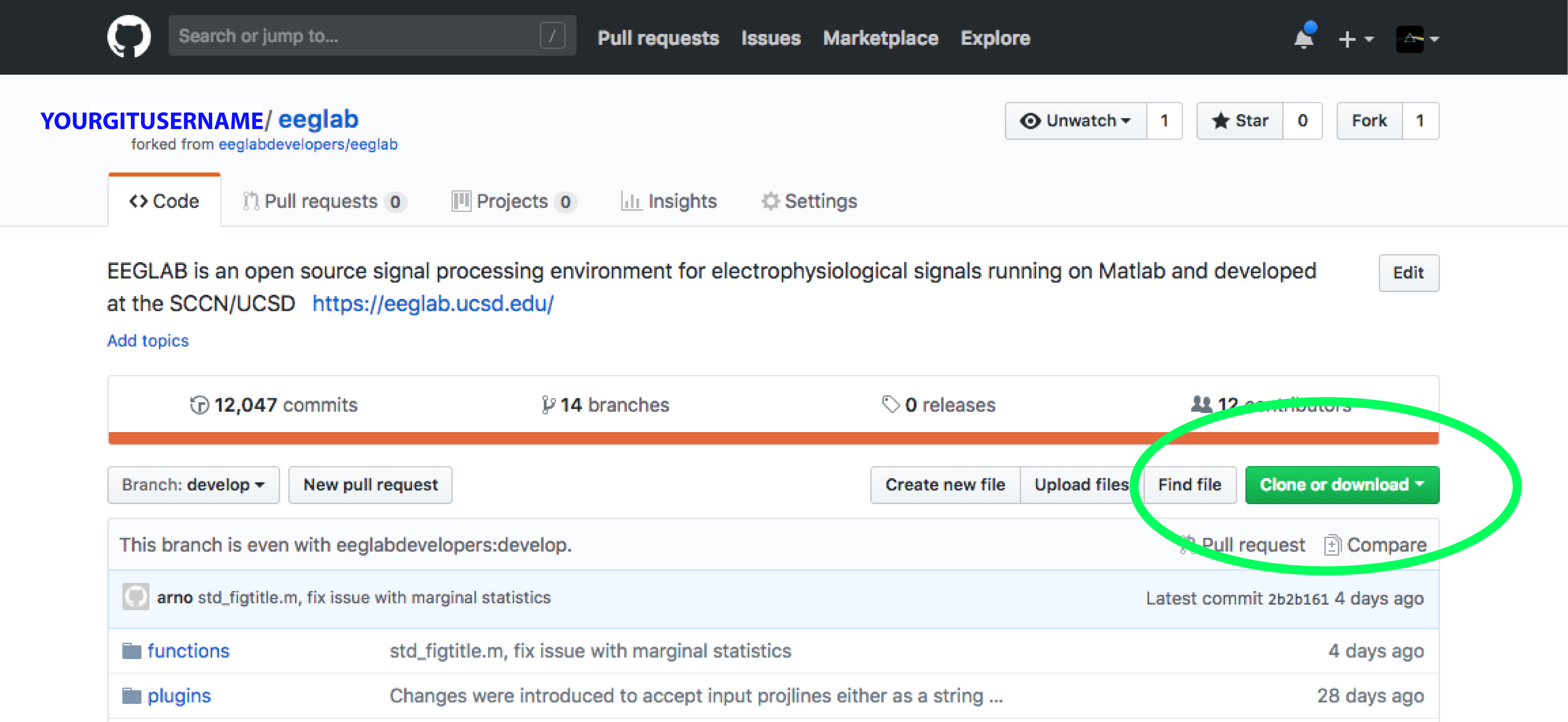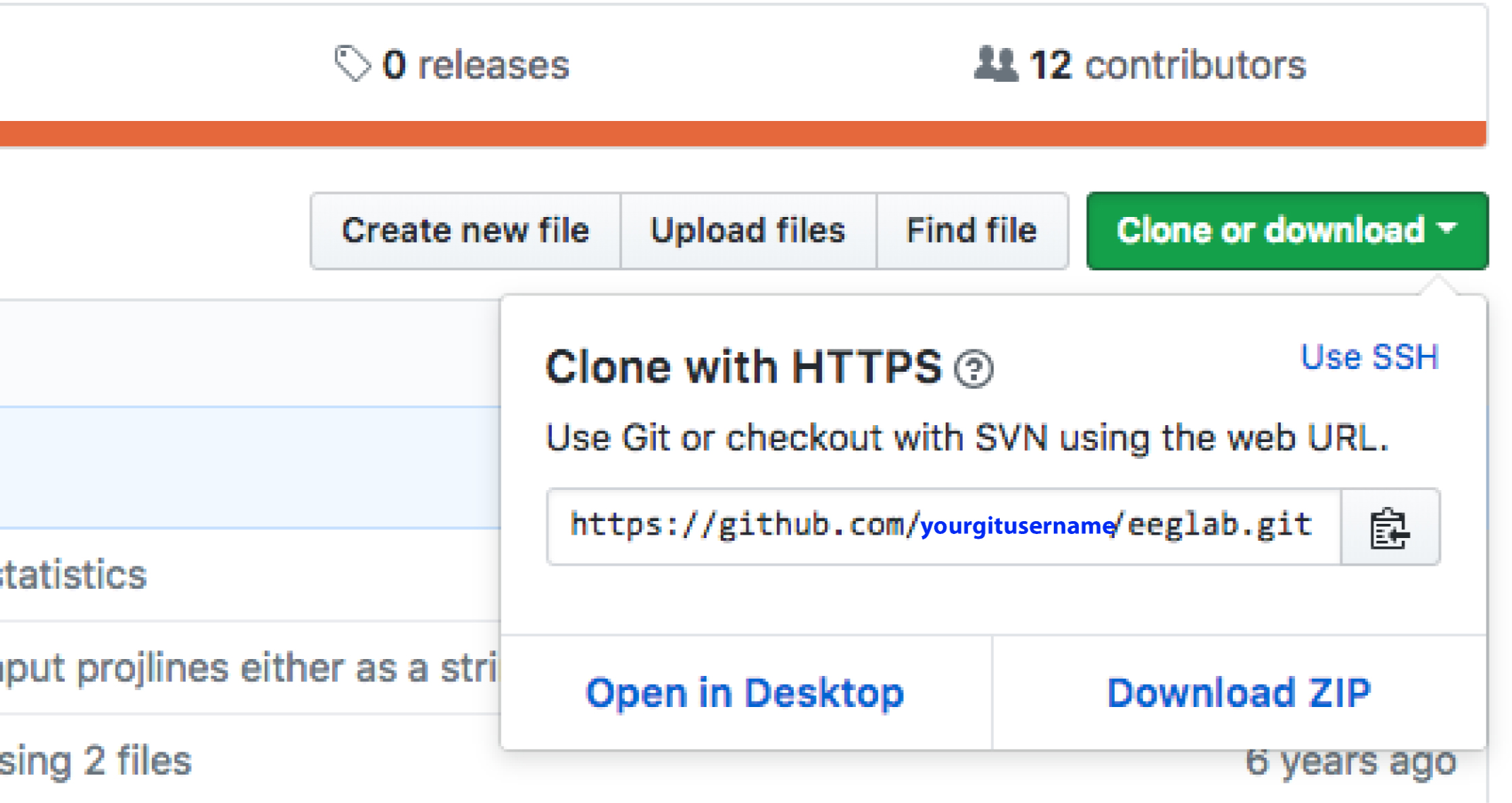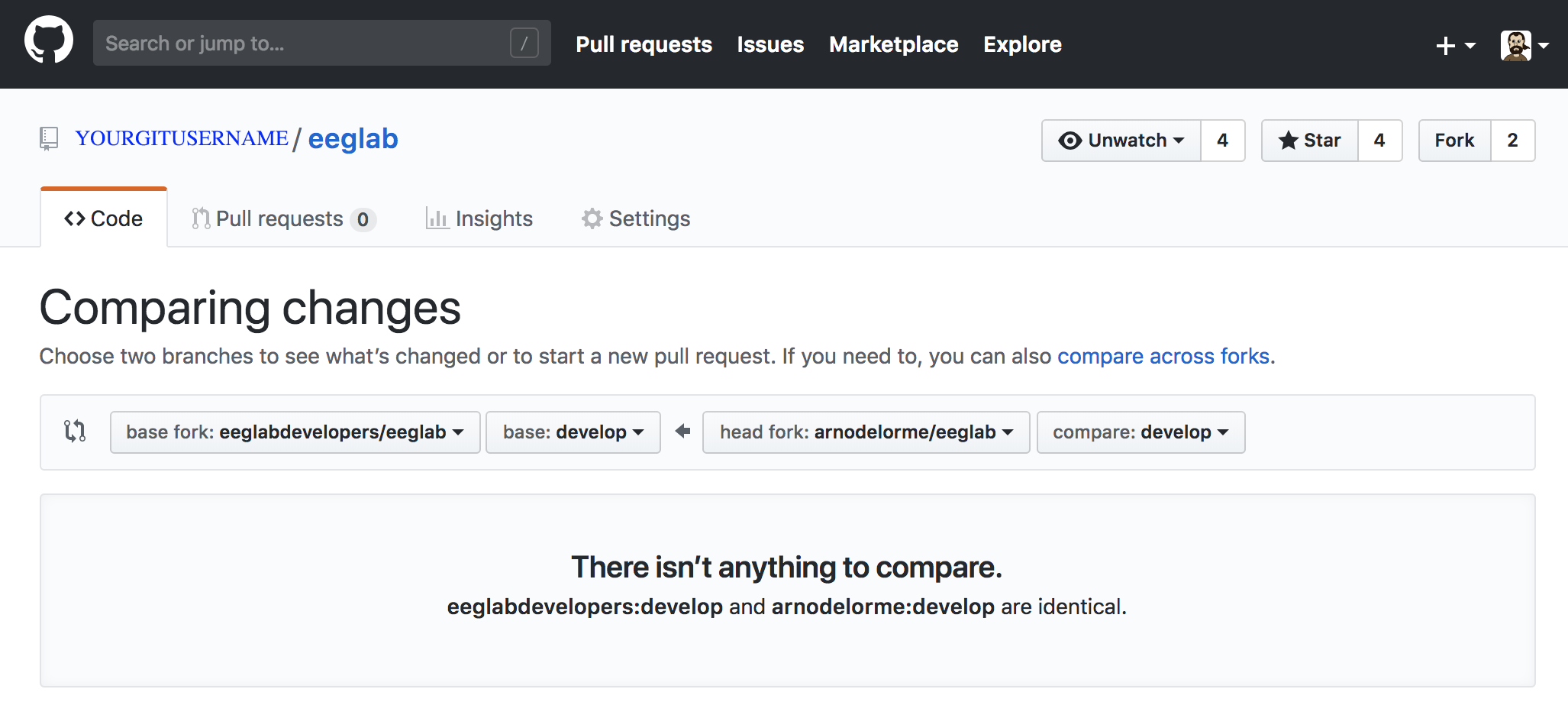Contributing to the EEGLAB core code
The main EEGLAB repository is not the place to add new functions. Instead, this is done by creating EEGLAB extensions/plugins. However, it is possible to modify the core code to either fix bugs, or add minor improvements to existing functions.
Table of contents
EEGLAB development model
EEGLAB history
The chief EEGLAB software architects are Arnaud Delorme and Scott Makeig. The predecessor to EEGLAB, the ICA/EEG Toolbox (1997-2001), comprised functions written by Makeig with Tony Bell, Colin Humphries, Sigurd Enghoff, Tzyy-Ping Jung, Te-Won Lee, and others, was first released on the Web in 1997 by Scott Makeig at the Computational Neurobiology Laboratory of Terrence Sejnowski at The Salk Institute, La Jolla.
The first version of the integrated EEGLAB toolbox was written there by Delorme and Makeig with subsequent contributions by many, including Marissa Westerfield, Jörn Anemüller, Luca Finelli, Robert Oostenveld, Hilit Serby, Toby Fernsler, Nima Shamlo Bigdeley, Jason Palmer, and many others. Dedicated beta testers include Andreas Romeyke and his team, who developed a test suite for EEGLAB, and other advanced users, including Stefan Debener and Andreus Widmar.
EEGLAB development is now centered at the Swartz Center for Computational Neuroscience (SCCN) of the Institute for Neural Computation at the University of California San Diego (UCSD). Core EEGLAB maintenance and development is supported by the US National Institute of Neurological Disorders and Stroke (NINDS).
The EEGLAB core code cannot be modified by third parties directly. Instead, users submits pull requests. EEGLAB core developers then review the code and add it to the repository.
For third-party developers, we welcome collaborations with users and open-source developers to expand and improve EEGLAB functions and/or independently write and release EEGLAB plugin/extension applications and environments. If you have written plugins for use in your laboratory, please consider releasing them for use by others, as described on this page.
EEGLAB is under active open-source development. Together with user developers, we are extending its capabilities to include across-subject general linear model statistics. User-contributed features and suggestions are welcome, and we encourage and plan to interconnect EEGLAB with other MATLAB-compatible toolboxes.
Open-source model
EEGLAB is an open-source software environment and is available free of charge to any user.
However, EEGLAB requires that you purchase and install the commercial MATLAB software environment. MATLAB version 2008b or later is required; We recommend using the latest version of MATLAB. MATLAB and EEGLAB run under Linux/Unix, Mac OS X, or Windows. Purchasing MATLAB can be expensive, though the MATLAB student version is usually priced near $50 US.
We have attempted to remove all dependencies on add-on MATLAB toolboxes. Thus, no additional toolboxes are necessary to run the EEGLAB core distribution. However, some advanced plugin toolboxes may use functions from a specific MATLAB toolbox: see their documentation for details.
Note that all EEGLAB processing functions (not its graphic interface) also can be run under the free Octave environment. EEGLAB also exists as a compiled program that does not require MATLAB.
License and credits
EEGLAB is distributed under the BSD license. Any contributed functions we add to EEGLAB will be made available for free commercial and non-commercial use under this license.
Contributors are acknowledged on GitHub, which record commits made to the main source code.
Consider writing an extension or plugin option, as described in the section below. EEGLAB extensions allow authors to flexibly incorporate new functions into the EEGLAB menu of every user who has downloaded the extension. The authors also retain all commercial rights to the functions they write.
Code of conduct
We strive to follow a code of conduct emphasizing community, collaboration, respect, and responsibility first outlined by the Ubuntu community.
Using GIT to contribute code
To contribute code to the EEGLAB core code, fork the code and create a pull request as indicated below. You will need a Github account to perform these operations but do not require any special permission from us.
Forking the EEGLAB repository
The main EEGLAB repository is not the place to add new functions. If you want to add new functionality, write an EEGLAB plugin instead.
Why fork the EEGLAB repository?
This page assumes that you are somewhat familiar with GitHub, Git, and version control.
Forking (copying) a software repository makes a copy of the repository that belongs to you. This allows you to experiment without affecting the existing code. Once you are done with your changes, you will be able to transfer them (push them) to the main repository by using pull requests (this could have been referred to as push requests, but the software community decided to name it from the perspective of the main repository, which then is pulling in your changes). This page will introduce you to the basics of forking the EEGLAB repository. Github makes the procedure very simple.
Forking the EEGLAB repository
To fork the EEGLAB repository from Github, follow these two simple steps:
- On Github, go to the EEGLAB repository
- Click Fork in the top right corner of the window (See the figure below).

Once you have executed these two steps, you will have successfully created your own copy of the EEGLAB repository. The new repository will look exactly like the EEGLAB repository you forked, but the forked copy will be under your username account.

Working on your forked copy
Once you have created your fork in Github, you will need to set up git in your computer to start working on your EEGLAB code copy. Then you will need to clone the forked repository to your computer.
- Go to the forked repository page in Github. This is the same page described in the figure above.
- Look on the right side of the page for the button Clone or download and click it.

- Click in the clone HTTPS section to copy the link.

- Open a terminal on your computer and type git clone and then paste and execute the link you copied in the previous step.
$git clone https://github.com/yourgitusername/eeglab.git
After following these steps, you will be ready to start modifying the EEGLAB code.
Issuing a pull request
Once you are satisfied with your code changes, commit them to GitHub. Then, go back to Github and issue a pull request. Once your changes are evaluated and approved by the EEGLAB team, they will be merged into the EEGLAB master code.

This brings you to a screen where you can select the forked branch to merge into the EEGLAB repository. NOTE: Always merge into the “develop” branch of EEGLAB.

Considerations regarding pull requests
For expedited approval:
- If you have added a new feature, make sure it works both from the graphic interface and from the MATLAB command line. Please send us a simple test script to demonstrate this.
- Run the test cases on the modified function. If possible, add the test case to the EEGLAB test case repository.
- You can never add too much documentation. Make sure you document your changes clearly and thoroughly!
- Issue pull request for single-function changes.
- Avoid making large numbers of cosmetic changes (indentation, etc.). If there are too many changes, they take a long time to review and are often rejected.